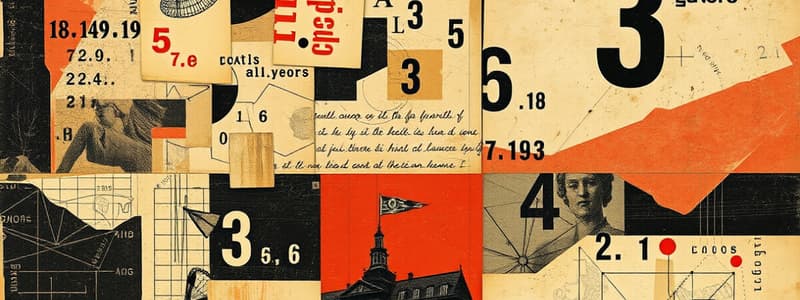Podcast
Questions and Answers
Which statement about rational numbers is true?
Which statement about rational numbers is true?
- All repeating decimals are irrational numbers.
- Rational numbers can be expressed as a fraction where the numerator and denominator are both integers. (correct)
- Rational numbers are only whole numbers.
- Only terminating decimals can be classified as rational numbers.
What characterizes an irrational number?
What characterizes an irrational number?
- It is a non-terminating, non-repeating decimal. (correct)
- It can either terminate or have a repeating decimal pattern.
- It includes integers and fractions.
- It can be written as a fraction of two integers.
What best describes the order of elements in a set?
What best describes the order of elements in a set?
- The order of elements is crucial and affects the set's identity.
- The order of elements is irrelevant and does not affect the set's identity. (correct)
- Elements must always include a specific reference point.
- Elements must be listed from largest to smallest.
Which of the following sets is well defined?
Which of the following sets is well defined?
Which of the following correctly uses the roster method to represent a set?
Which of the following correctly uses the roster method to represent a set?
How do you express that -3 is not part of the natural numbers using mathematical notation?
How do you express that -3 is not part of the natural numbers using mathematical notation?
Which of the following statements is true regarding the solution set of an equation?
Which of the following statements is true regarding the solution set of an equation?
How is the set of natural numbers commonly referred to?
How is the set of natural numbers commonly referred to?
What is the primary purpose of an ellipsis (...) when describing a set?
What is the primary purpose of an ellipsis (...) when describing a set?
Which word description correctly defines Set A?
Which word description correctly defines Set A?
Flashcards are hidden until you start studying
Study Notes
Basic Concepts of Sets
- A set is a collection of distinct objects called elements or members.
- Example of a set: S = {spring, summer, fall, winter} representing seasons.
- The order of elements in a set does not matter; S = {winter, spring, fall, summer} is equivalent to the first example.
Methods to Define Sets
- Word Description: Sets can be described using natural language.
- Roster Method: Lists elements within braces, separating them with commas, such as {1, 2, 3, 4} for natural numbers less than 5.
Types of Numbers
- Natural Numbers: Also called counting numbers; denoted as N.
- Integers: Include positive, negative whole numbers, and zero.
- Rational Numbers: Can be expressed as p/q where p and q are integers, and q ≠ 0. Terminating or repeating decimals are rational numbers.
- Irrational Numbers: Cannot be expressed as a fraction, represented by non-terminating, non-repeating decimals, e.g., 0.353353335....
Set Definitions
- A well-defined set allows for clear determination of whether an item is included.
- Example of a well-defined set: letters of the English alphabet. Conversely, the set of "great songs" lacks clear criteria.
- Symbol ∈ denotes membership, while ∉ indicates non-membership.
Empty Set
- The empty set contains no elements, represented as ∅ or { }.
Set-Builder Notation
- Describes sets based on properties of their elements, e.g., {x | x ∈ N and x > 7} for natural numbers greater than 7.
Finite Sets
- A set is finite if it has a limited number of elements.
- The cardinality of a set denotes the number of elements, symbolized as n(A).
- Example: For A = {1, 4, 6, 9}, the cardinality is n(A) = 4.
Equal and Equivalent Sets
- Two sets are considered equal if they contain the same elements, regardless of order.
- Sets are equivalent if they contain the same number of elements but may differ in their actual elements.
Studying That Suits You
Use AI to generate personalized quizzes and flashcards to suit your learning preferences.




